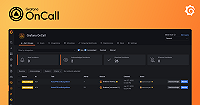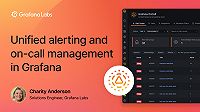Caution
As of 2025-03-11, Grafana OnCall OSS has entered maintenance mode, and will be archived on 2026-03-24. No further feature development will occur; however, we will still provide fixes for critical bugs and for valid CVEs with a CVSS score of 7.0 or higher. For more information, refer to our blog post.
Inbound Webhook integrations for Grafana OnCall
Grafana OnCall directly supports many integrations, those that aren’t currently listed in the Integrations menu can be connected using the webhook integration and configured alert templates.
With the webhook integration, you can connect to any alert source that isn’t listed in the Create Integration page.
There are two available formats, Webhook and Formatted Webhook.
Webhook will pull all of the raw JSON payload and display it in the manner that it’s received.
Formatted Webhook can be used if the alert payload sent by your monitoring service is formatted in a way that OnCall recognizes.
The following fields are recognized, but none are required:
alert_uid: a unique alert ID for grouping.title: a title.image_url: a URL for an image attached to alert.state: eitherokoralerting. Helpful for auto-resolving.link_to_upstream_details: link back to your monitoring system.message: alert details.
To configure a webhook integration:
- In the Integrations tab, click + New integration to receive alerts.
- Select either Webhook or Formatted Webhook integration.
- Follow the configuration steps in the How to connect section of the integration settings.
- Use the unique webhook URL to complete any configuration in your monitoring service to send POST requests. Use any http client, e.g. curl to send POST requests with any payload.
For example:
curl -X POST \
https://a-prod-us-central-0.grafana.net/integrations/v1/formatted_webhook/m12xmIjOcgwH74UF8CN4dk0Dh/ \
-H 'Content-Type: Application/json' \
-d '{
"alert_uid": "08d6891a-835c-e661-39fa-96b6a9e26552",
"title": "The whole system is down",
"image_url": "https://upload.wikimedia.org/wikipedia/commons/e/ee/Grumpy_Cat_by_Gage_Skidmore.jpg",
"state": "alerting",
"link_to_upstream_details": "https://en.wikipedia.org/wiki/Downtime",
"message": "Smth happened. Oh no!"
}'To learn how to use custom alert templates for formatted webhooks, see Configure alerts templates.




